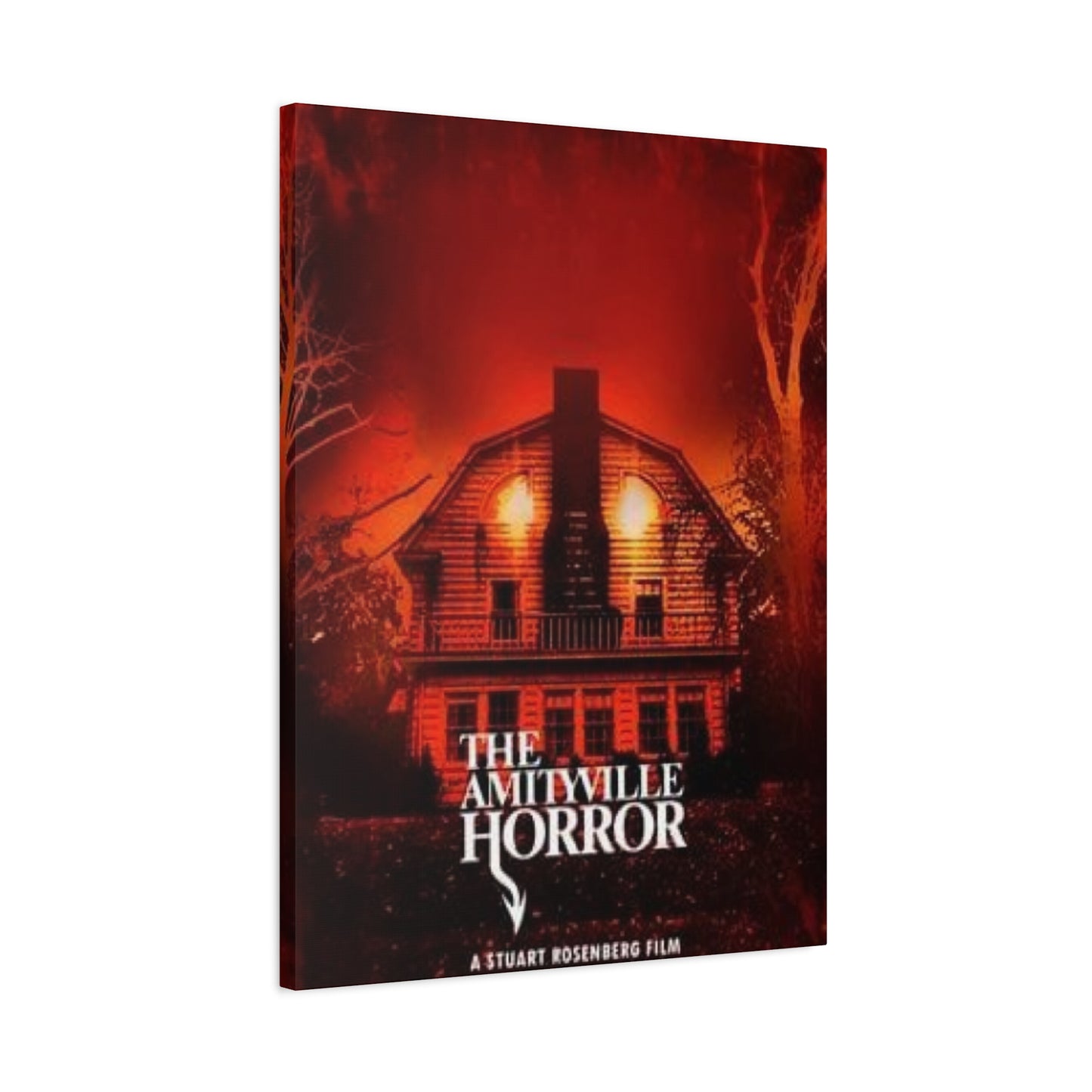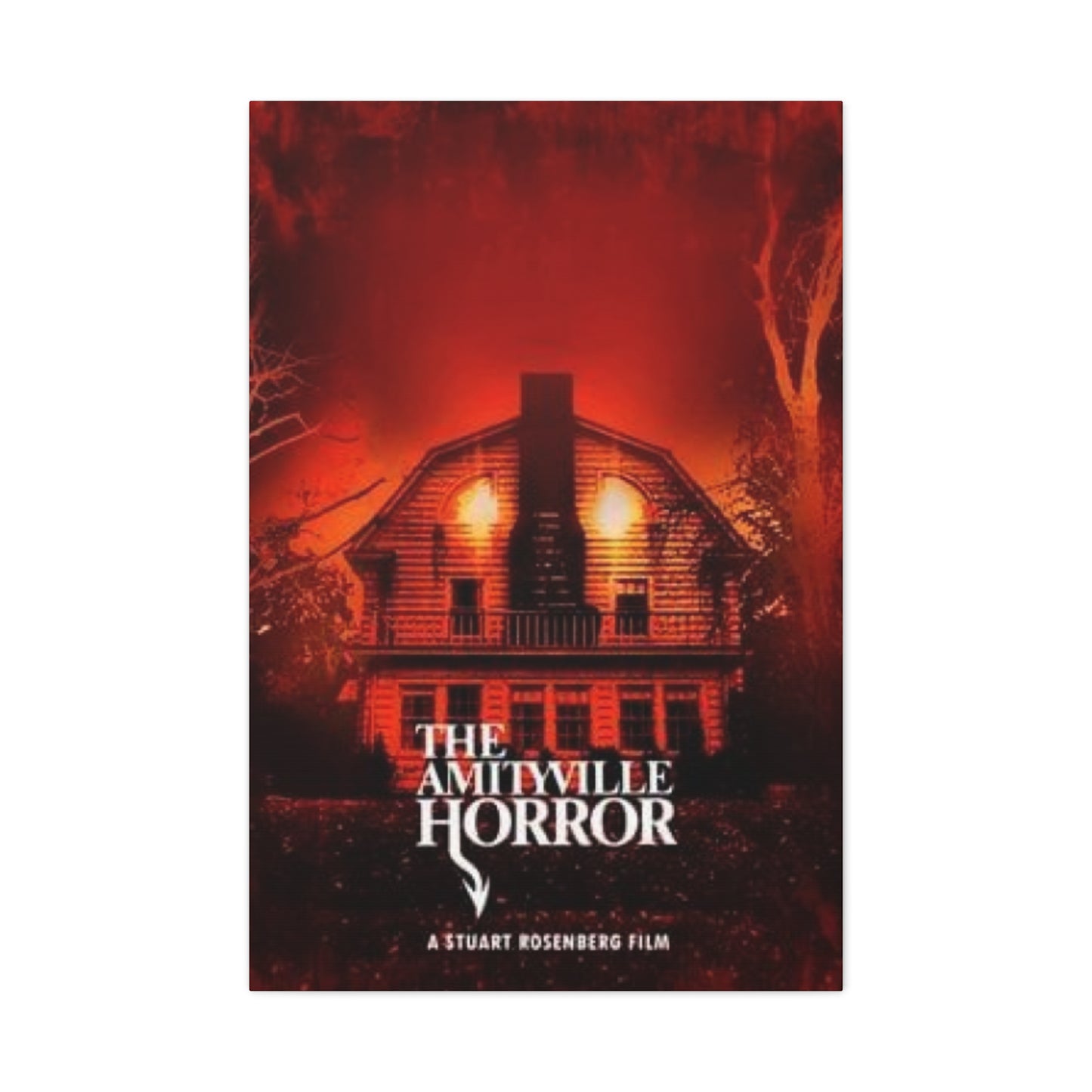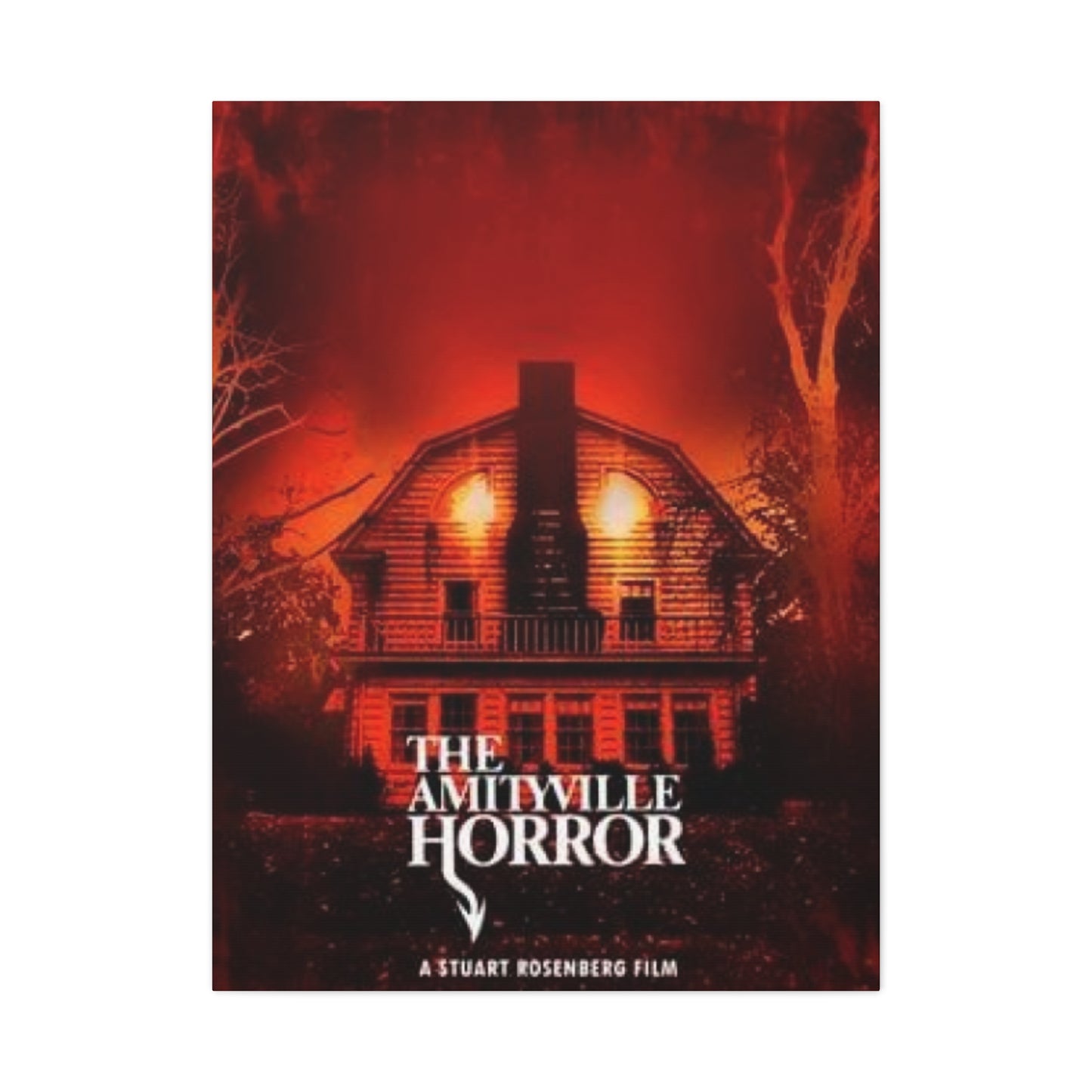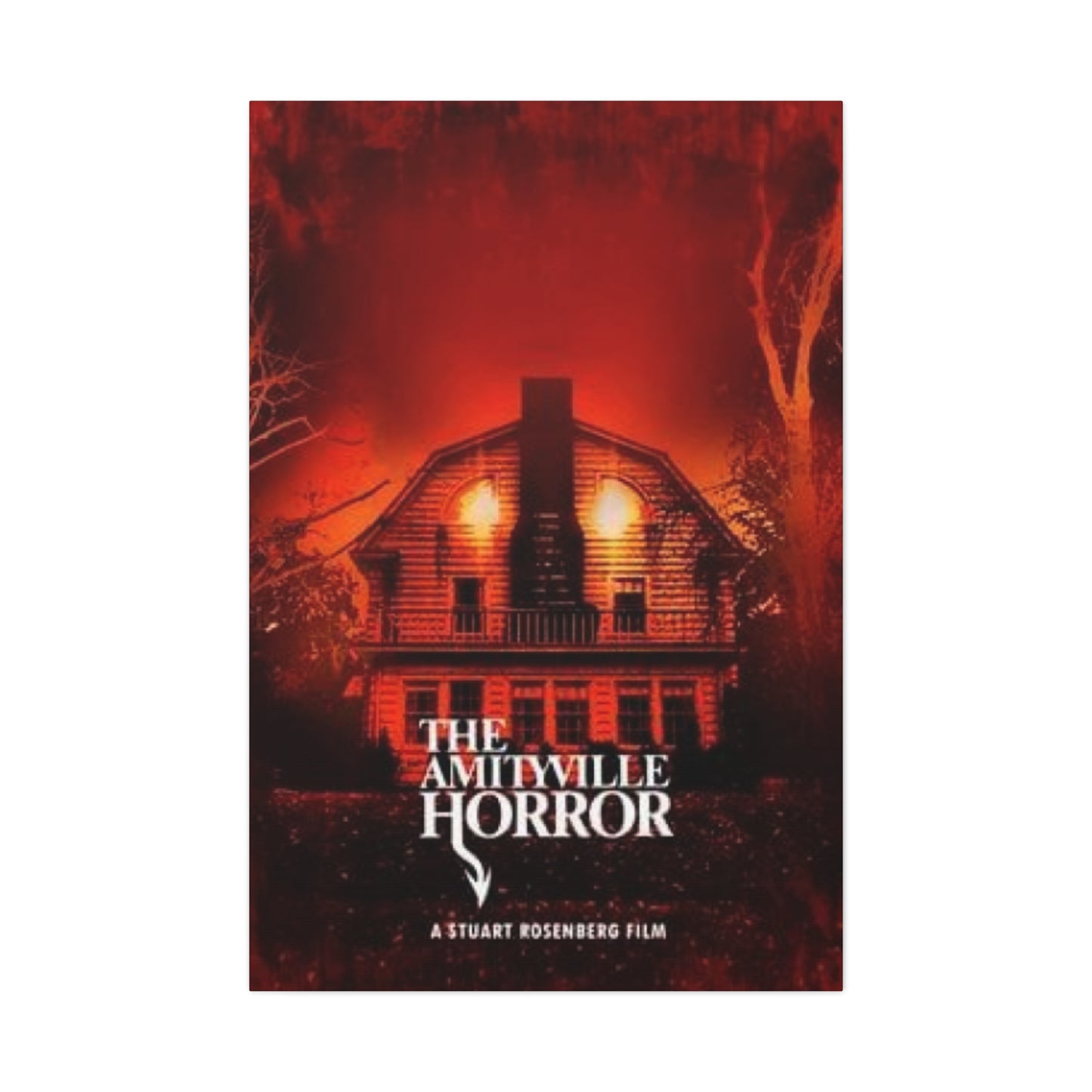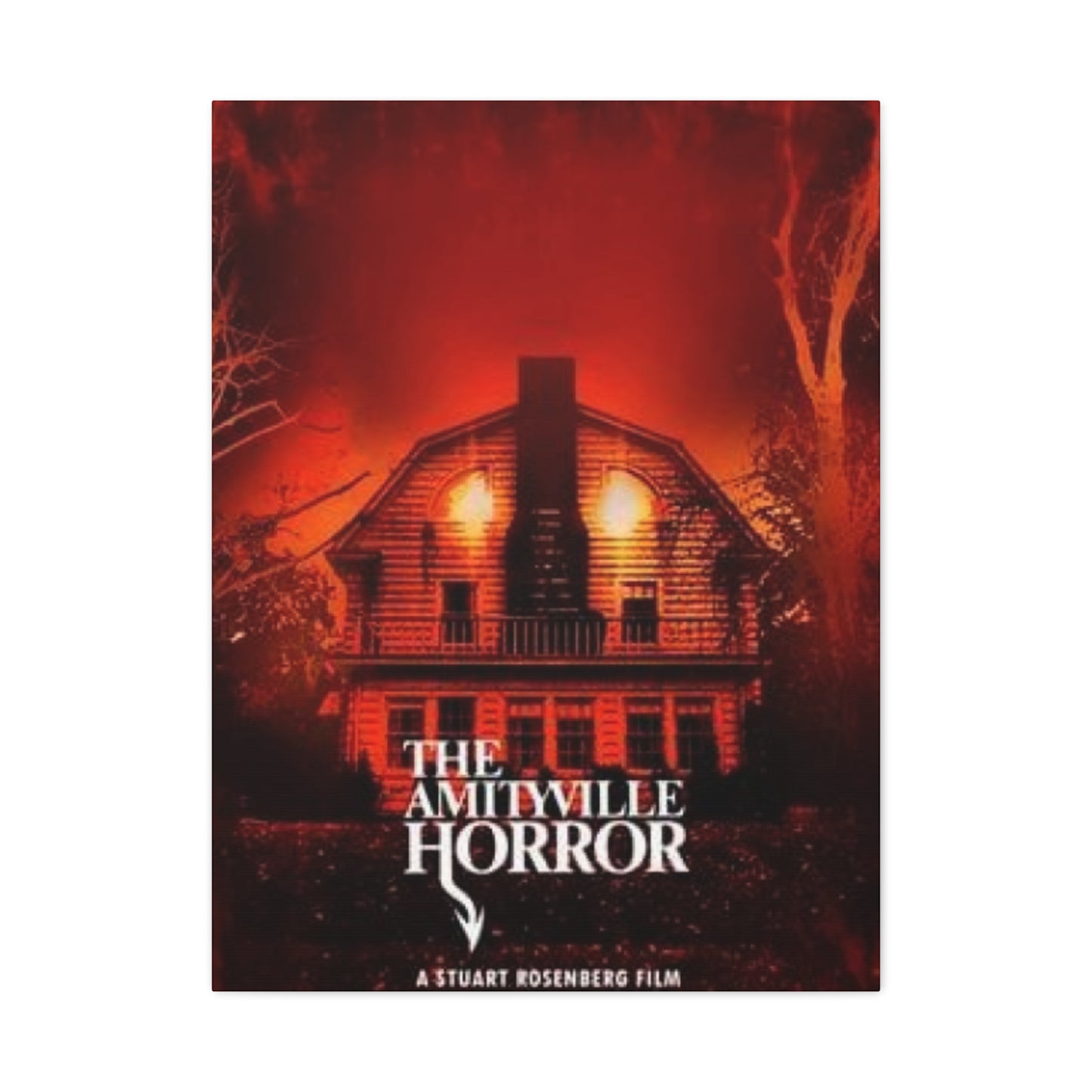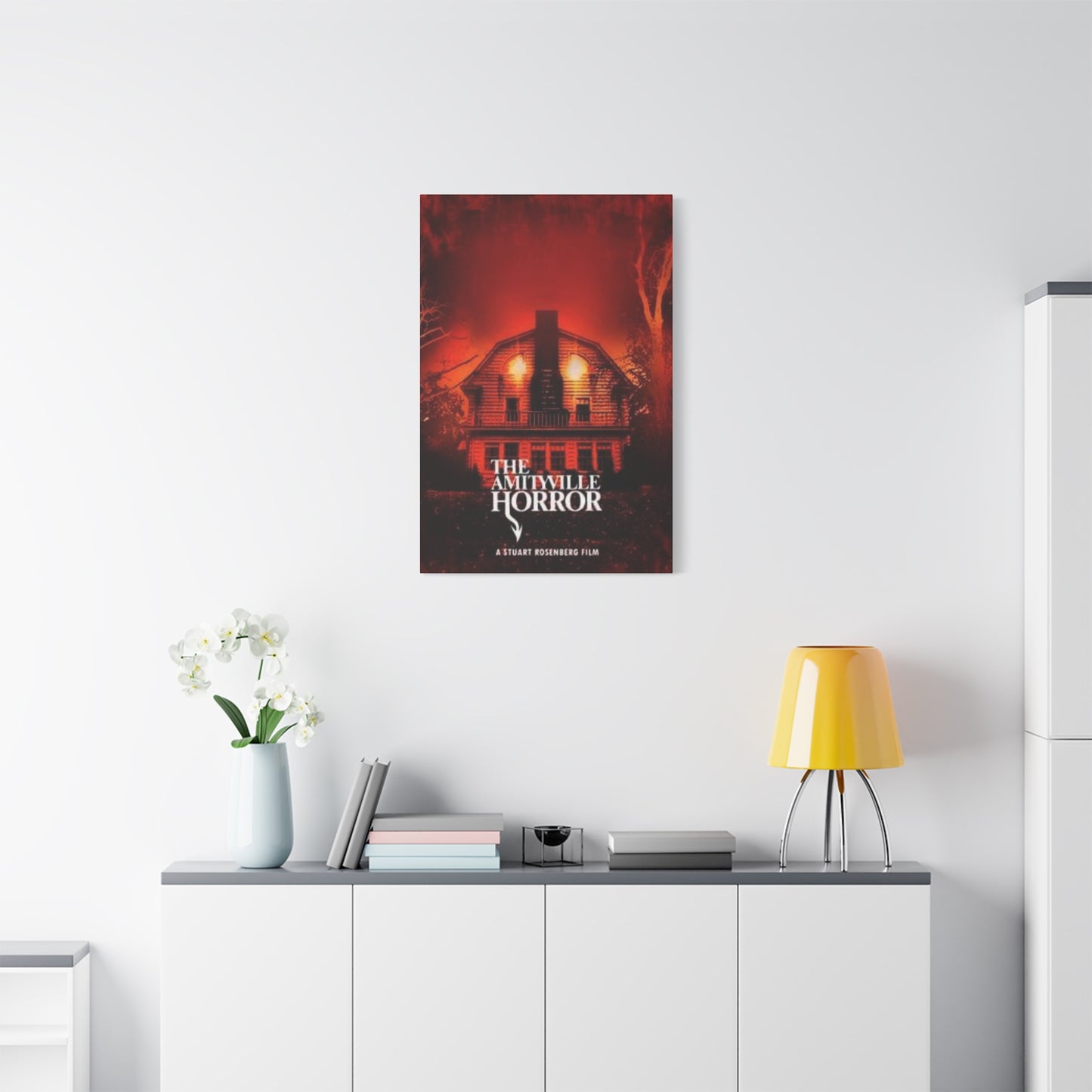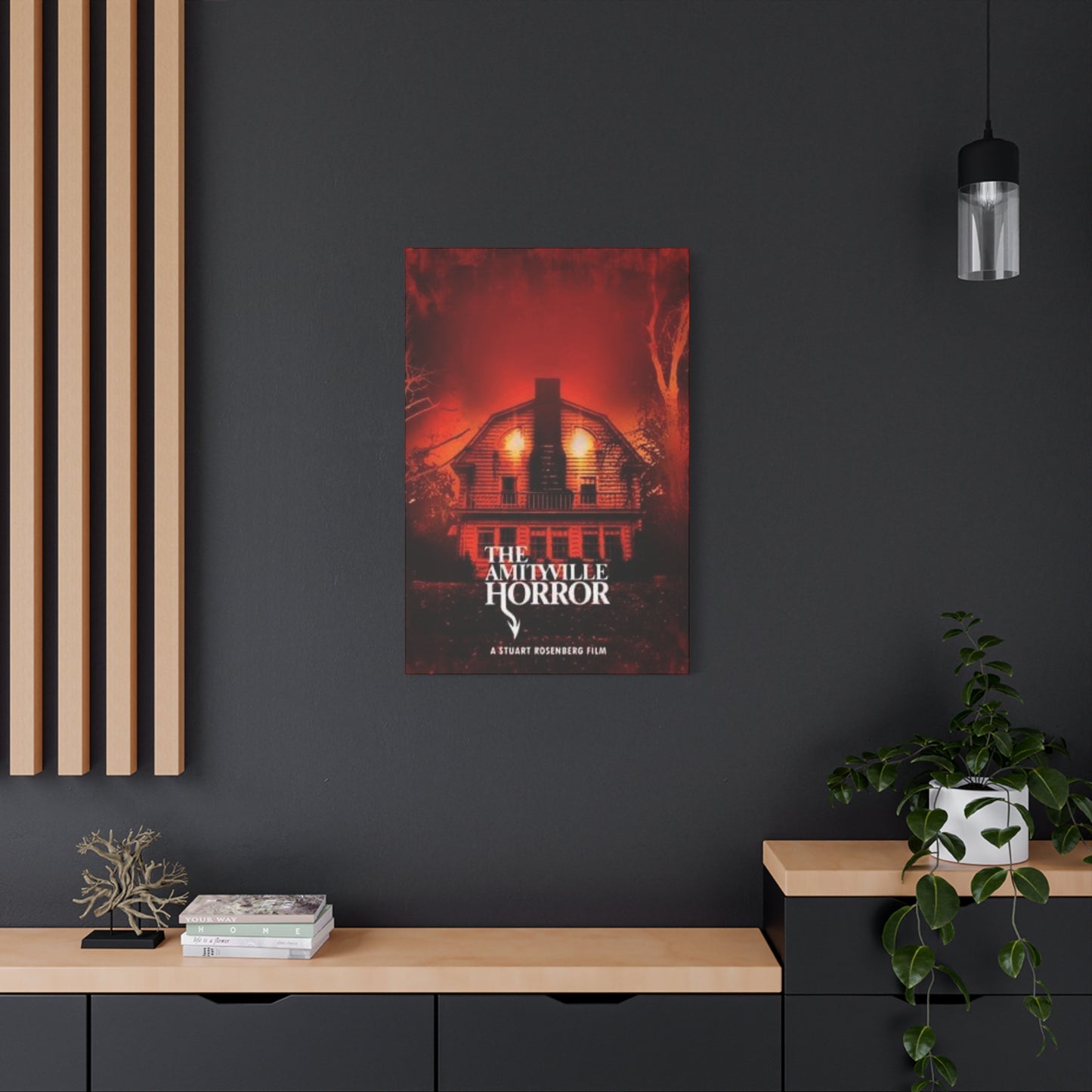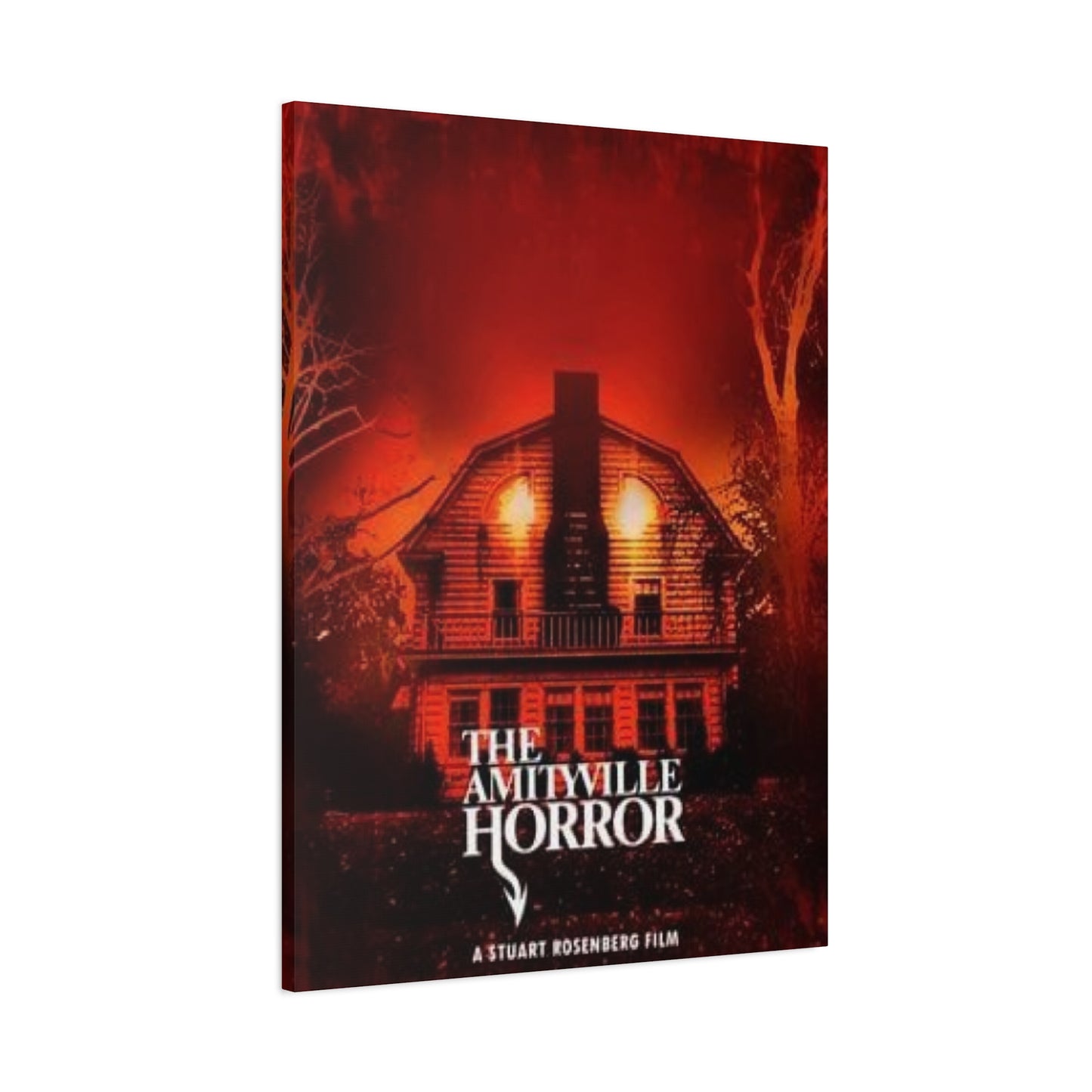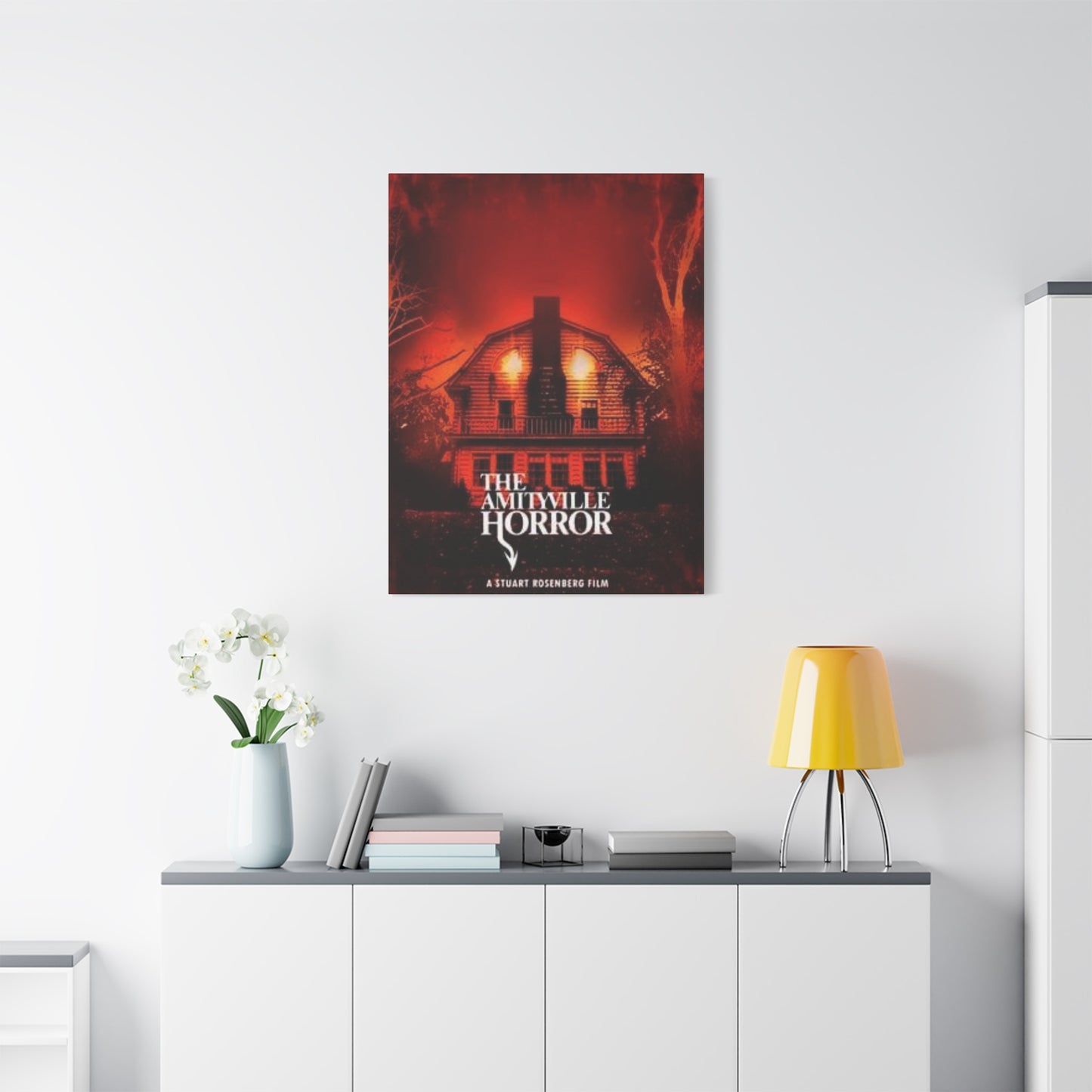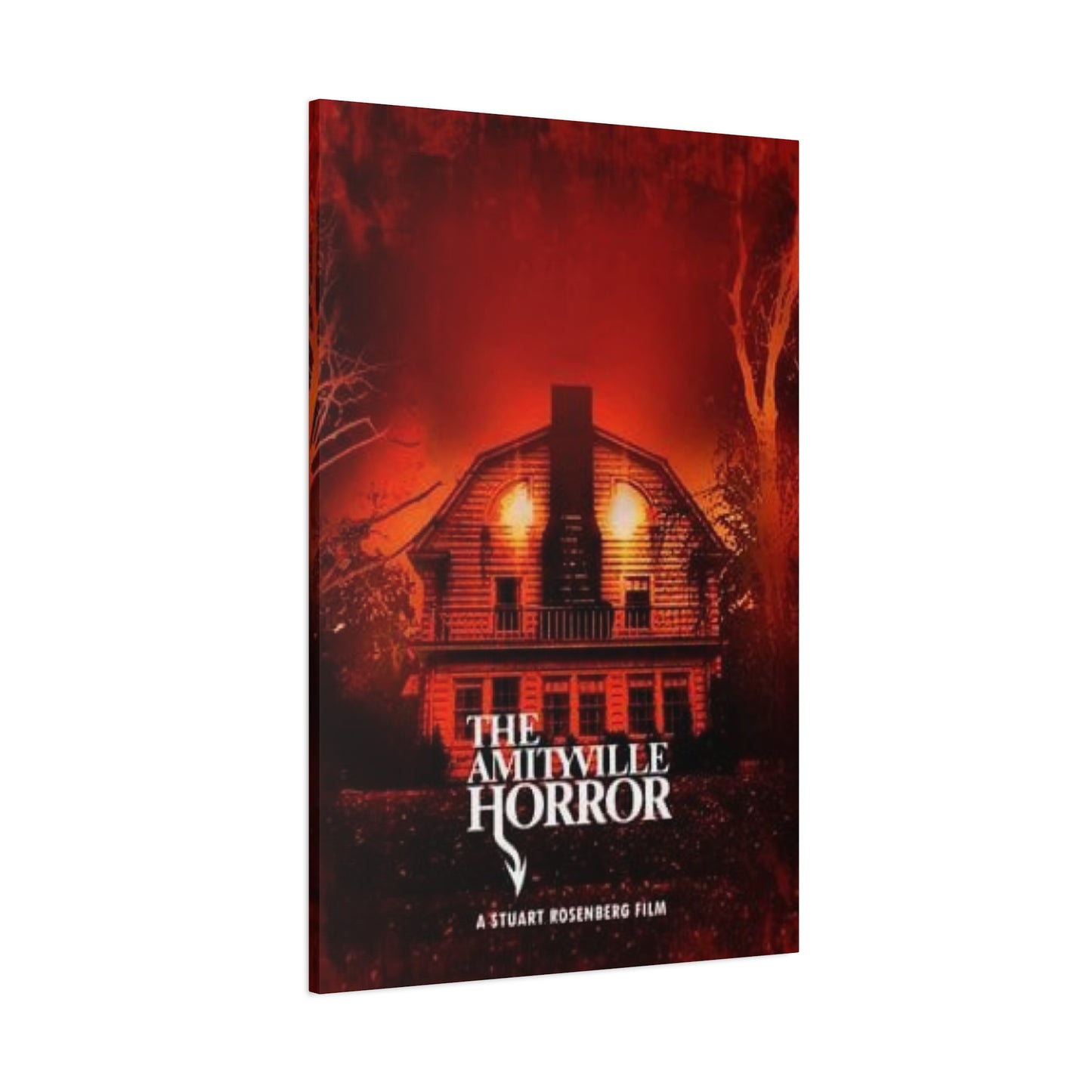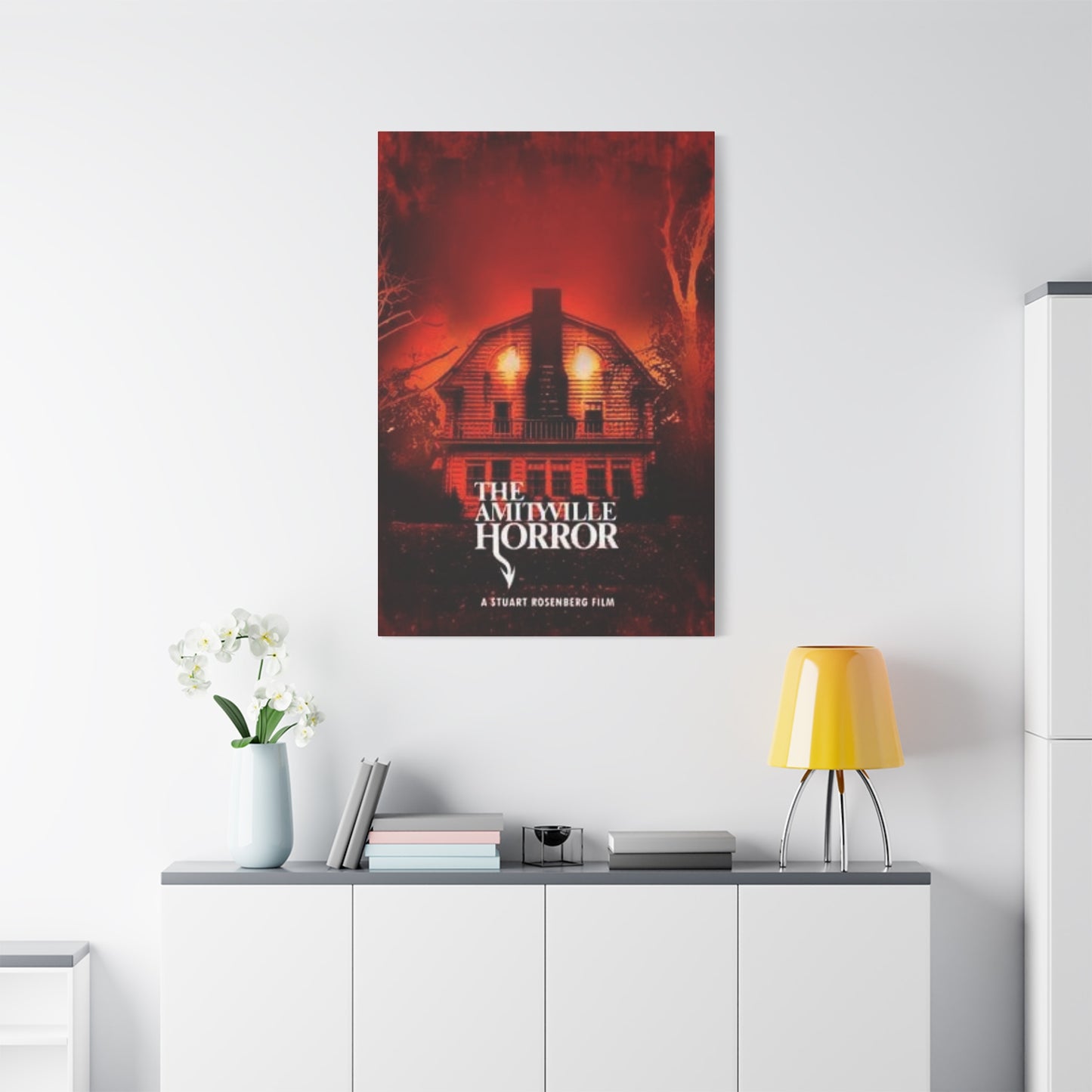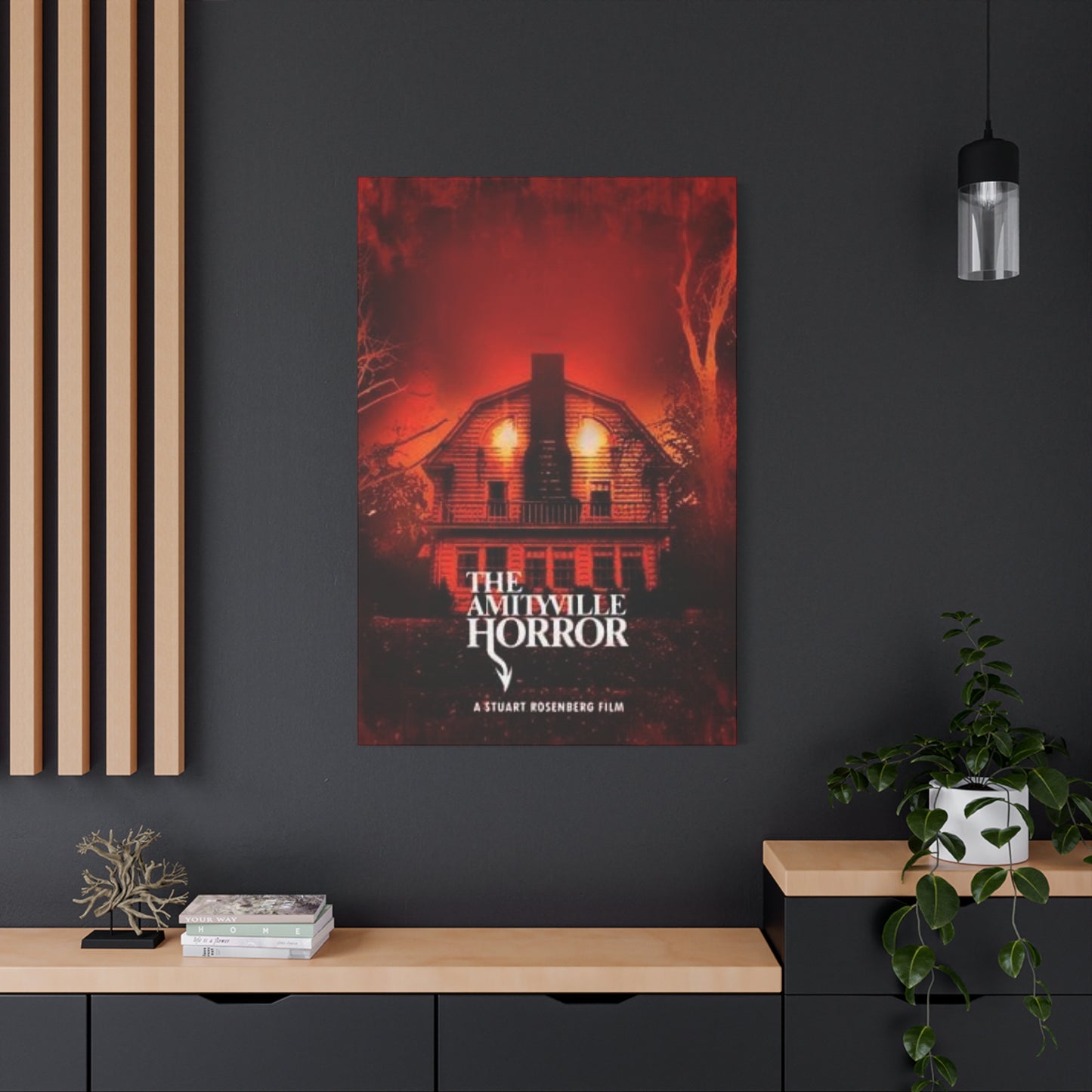Amityville Horror Poster Wall art: Elevate Your Space with Legendary Supernatural Cinema Art
The world of horror cinema has gifted us countless memorable moments, but few films have left as indelible a mark on popular culture as the story of a haunted house on Long Island. For enthusiasts of supernatural cinema and collectors of memorabilia alike, decorating living spaces with artwork that celebrates these chilling narratives has become an increasingly popular way to express personal taste and appreciation for the genre. Among the most sought-after pieces in this category are posters celebrating one of the most notorious haunting stories ever committed to film. These distinctive pieces of visual art serve multiple purposes, functioning as conversation starters, nostalgic tributes, and atmospheric additions to various interior design schemes.
The appeal of such artwork extends far beyond simple decoration. These posters represent a connection to a cultural phenomenon that has captivated audiences for decades, spawning numerous adaptations, books, debates, and continuing fascination with the events that inspired the original story. Whether displayed in dedicated entertainment spaces, personal collections, or integrated into broader design themes, these pieces carry with them the weight of cinematic history and the enduring power of supernatural storytelling. The visual elements captured in these posters have become instantly recognizable symbols within horror culture, making them valuable additions for anyone seeking to create an atmosphere that acknowledges the darker corners of human imagination.
Classic Horror: Amityville Poster Art
The artistic legacy of posters celebrating this infamous haunted house tale represents a fascinating intersection of commercial design, cinematic promotion, and cultural iconography. Original promotional materials created for the initial theatrical release employed bold visual strategies that have since become templates for horror marketing. The distinctive imagery featured in these early designs captured essential elements of the story while creating an immediate emotional response in potential viewers. Dark color palettes dominated by deep reds, blacks, and sickly greens established an unmistakable mood before audiences even entered theaters. Typography choices ranged from dripping, blood-like lettering to stark, institutional fonts that suggested official documentation of terrifying events.
The architectural elements featured prominently in this artwork have become synonymous with the haunted house subgenre itself. The distinctive Dutch Colonial style of the house, with its characteristic quarter-circle windows resembling malevolent eyes, provides an instantly recognizable focal point. These windows, often illuminated from within with an eerie glow in poster designs, suggest a consciousness within the structure itself, a watching presence that awaits unsuspecting inhabitants. The positioning of the house within the composition typically emphasizes isolation and foreboding, with storm clouds gathering overhead or surrounding darkness encroaching from the edges of the frame.
Artistic techniques employed in these classic designs demonstrate sophisticated understanding of psychological impact. Asymmetrical compositions create visual tension, while strategic use of negative space generates feelings of emptiness and dread. Color temperature plays a crucial role, with cool tones suggesting supernatural presence and warm tones hinting at the false security of domestic life about to be shattered. Many designs incorporate subtle details that reward closer inspection, such as shadowy figures in windows, distorted reflections, or symbolic elements referencing specific events from the narrative. This layered approach to visual storytelling ensures that these posters remain engaging even after repeated viewing.
The evolution of poster art for subsequent releases and anniversary editions has provided collectors with a rich variety of aesthetic approaches to the same core material. Some designs embrace minimalism, reducing the imagery to essential symbolic elements that convey maximum impact with minimum detail. Others adopt maximalist strategies, cramming the composition with references to specific scenes, characters, and supernatural manifestations. Vintage-style reproductions intentionally recreate the look and feel of original theatrical materials, complete with artificially aged paper stocks and printing techniques that mimic period-appropriate processes. Contemporary reinterpretations apply modern design sensibilities, sometimes incorporating digital techniques, photographic manipulation, or entirely new artistic interpretations of familiar themes.
Add Spooky Charm with Amityville Horror Posters
Incorporating horror-themed artwork into residential or commercial spaces requires thoughtful consideration of context, placement, and surrounding design elements. These particular posters offer unique advantages for those seeking to introduce atmospheric elements without overwhelming their environments. The recognizable nature of the imagery provides common ground for conversations with visitors, while the artistic quality of well-designed pieces ensures they function as legitimate decorative elements rather than mere novelty items. Strategic placement can transform ordinary rooms into spaces with distinct personality and mood, creating zones within homes that cater to specific interests and aesthetic preferences.
Living rooms and common areas present particular opportunities for displaying such artwork in ways that integrate with broader design schemes. When positioned alongside other framed pieces in gallery wall arrangements, horror posters can participate in visual narratives that span multiple genres and time periods. The key lies in finding balance between the darker themes of the horror content and the overall atmosphere desired for spaces where families gather and guests are entertained. Selecting frames that complement existing furnishings helps bridge the gap between niche interest and cohesive interior design. Matte black frames provide classic versatility, while weathered wood options can emphasize vintage character, and sleek metal frames offer contemporary sophistication.
Lighting considerations dramatically affect how these posters present within their environments. Natural daylight can wash out darker imagery during certain hours, making artificial lighting solutions essential for maintaining intended visual impact. Picture lights mounted above frames provide focused illumination that highlights details while creating dramatic shadows around the edges. Recessed lighting or track lighting systems offer flexibility in directing attention to specific pieces within larger collections. For truly immersive effects, some enthusiasts incorporate colored LED lighting behind posters or around frames, using reds, greens, or purples to enhance the supernatural atmosphere suggested by the imagery itself.
Bedroom applications of horror artwork follow different considerations than public spaces. Personal sleeping quarters allow for more individualized expression without concern for guest reactions, making them ideal locations for larger or more intense pieces. Positioning such artwork to be visible from the bed creates a focal point that reinforces chosen themes, though some individuals prefer placement on walls not directly in sightlines during rest hours. The psychological impact of surrounding oneself with darker imagery during sleep hours varies significantly among individuals, with some finding such environments comforting in their familiarity and others discovering they prefer lighter aesthetics in their most private spaces.
Office and workspace applications demonstrate how horror aesthetics can coexist with professional or creative environments. Home offices, creative studios, and entertainment industry workspaces often feature such displays as expressions of personal passion that inform professional identity. The presence of genre-specific artwork can signal to clients and colleagues shared interests while establishing the space as belonging to someone with defined tastes and cultural literacy. For those working in creative fields, surrounding oneself with inspiring imagery from influential works can serve practical purposes beyond mere decoration, providing visual prompts for imagination and reminders of storytelling excellence.
Iconic Horror Art for Your Walls
The status of certain horror films as cultural touchstones elevates their associated imagery beyond simple movie memorabilia into the realm of genuine iconography. Specific visual elements become shorthand for entire subgenres, storytelling approaches, and periods in cinematic history. The house that serves as the central location for this particular narrative has achieved such status, recognized even by those who have never seen the films or read the books. This universal recognition transforms posters featuring this imagery into statements that communicate beyond narrow fan circles, reaching into broader conversations about American folklore, supernatural beliefs, and the power of place in storytelling.
Artistic merit exists independently of subject matter, and well-designed horror posters demonstrate sophisticated application of design principles. Composition techniques guide viewer attention through visual hierarchies that emphasize key elements while maintaining overall balance. Color theory applications create emotional resonances that prepare audiences for the content they're about to encounter or remind enthusiasts of their experiences with the material. Typography choices reinforce thematic content through letterform selection, sizing, spacing, and positioning decisions that contribute to overall mood. When these elements combine successfully, the result transcends simple advertising to become legitimate art worthy of collection and display.
The investment potential of original theatrical posters and limited edition prints adds another dimension to their appeal. Vintage materials from initial releases have become valuable collectibles, with condition, provenance, and rarity determining market values that can reach substantial sums. Authentication becomes crucial in this market, as reproductions and forgeries attempt to capitalize on collector demand. Understanding printing techniques, paper stocks, distribution methods, and historical context helps collectors distinguish genuine articles from later productions. Even modern limited edition releases acquire value when produced in small quantities by respected artists or through official licensing arrangements that ensure quality and exclusivity.
Artistic interpretations by contemporary illustrators and designers have created an entire cottage industry around reimagined poster designs for classic films. Online marketplaces and specialty retailers offer countless variations on familiar themes, each bringing unique perspectives and styles to established material. Some artists emphasize photorealistic rendering that could pass for production stills, while others embrace stylization ranging from minimalist geometric designs to elaborate painted compositions. This variety ensures that collectors can find pieces that align with personal aesthetic preferences while still celebrating the core subject matter. Supporting independent artists through such purchases contributes to thriving creative communities centered around genre appreciation.
Cultural analysis of horror iconography reveals deeper meanings embedded in familiar imagery. The haunted house as architectural symbol carries psychological weight beyond simple fear responses, touching on themes of domesticity corrupted, American dream perverted, and the thin boundaries between safety and danger. Windows as eyes suggest not only supernatural presence but also the gaze of judgment, the watching that occurs in small communities, and anxieties about exposure and vulnerability. Religious symbolism frequently appears in artwork related to this particular narrative, reflecting the demonic possession elements central to the story and broader cultural anxieties about spiritual warfare and evil's manifestation in everyday settings.
Amityville Horror Poster: A Vintage Touch
Vintage aesthetics exercise powerful appeal in contemporary design culture, offering connections to perceived authenticity and craftsmanship from earlier eras. Posters created during original theatrical releases carry inherent historical value as documents of specific moments in entertainment history. The printing techniques available during those periods produced distinctive visual characteristics that cannot be perfectly replicated through modern methods. Offset lithography created particular color saturations and screening patterns that digital printing cannot duplicate exactly. Paper stocks from earlier decades possessed different textures, weights, and aging characteristics than contemporary materials. These physical properties contribute to the unique presence that genuine vintage pieces bring to collections.
Intentional aging and distressing techniques allow new productions to capture vintage character while remaining accessible to broader audiences. Artificial weathering processes can simulate decades of exposure, creating browned edges, subtle staining, and surface texture that suggests age without compromising structural integrity. Tea or coffee treatments applied to paper stocks before printing create overall toning that mimics oxidation. Strategic creasing and corner damage replicate the handling that vintage materials inevitably experienced. When executed with restraint and understanding of how genuine aging occurs, these techniques produce pieces that capture vintage spirit without misleading collectors about their actual age.
The nostalgia factor driving vintage aesthetic appreciation connects to broader cultural trends toward analog experiences in increasingly digital environments. Physical media, tangible objects, and analog aesthetics offer counterbalance to screen-dominated daily life. Collecting and displaying vintage-style posters participates in this movement, creating personal environments that acknowledge earlier eras while serving contemporary needs. The specific period evoked by this particular film's original release coincides with the late 1970s, an era now sufficiently distant to carry nostalgic weight while remaining within living memory for substantial portions of the population. This temporal positioning makes related artwork particularly resonant for multiple generations simultaneously.
Display methods that emphasize vintage character enhance the overall effect of period-appropriate materials. Traditional picture frames with visible aging, metal corners showing patina, or simple wooden constructions without contemporary refinements help maintain consistent aesthetic messaging. Avoiding ultramodern framing solutions preserves the temporal connection these pieces establish. Grouping multiple vintage or vintage-style pieces creates concentrated zones of period atmosphere more effective than isolated examples. Including non-horror vintage materials alongside genre-specific items demonstrates broader appreciation for the era rather than singular focus, potentially making collections more accessible to those less enthusiastic about darker content.
Preservation considerations for genuine vintage materials require balancing display desires with conservation needs. Exposure to direct sunlight causes irreversible damage to paper and inks, necessitating careful placement away from windows or implementation of UV-filtering glass. Humidity and temperature fluctuations accelerate deterioration, making climate-controlled environments ideal for valuable pieces. Acid-free mounting materials prevent chemical damage from contact with backing boards. Professional conservation and framing services offer expertise in protecting vintage materials while making them display-ready. For those possessing truly rare or valuable examples, consultation with paper conservators ensures appropriate handling and storage techniques that preserve investment value alongside aesthetic appeal.
Horror Fans: Amityville Poster Must-Have
Within dedicated fan communities, certain items achieve must-have status through combination of cultural significance, aesthetic appeal, and community consensus. For enthusiasts of supernatural horror cinema, possessing artwork related to this particular haunted house narrative represents fundamental collection building. The film's position within horror history as a defining entry in the haunted house subgenre makes associated imagery essential reference material. Serious collectors consider their collections incomplete without representation of this title, similar to how music enthusiasts might view certain landmark albums or literature fans regard specific classic volumes.
The community aspects of fandom create shared languages and reference points that collections both reflect and reinforce. Displaying recognized imagery signals membership in broader communities of appreciation, creating instant common ground with fellow enthusiasts. Online sharing of collection photographs, arrangement strategies, and acquisition stories builds connections across geographical distances. Conventions, meetups, and specialty events provide opportunities for in-person celebration of shared interests, with collection contents often serving as conversation starters and status indicators within these gatherings. The social dimensions of collecting transform solitary accumulation into participatory culture.
Completionist approaches to collecting drive some enthusiasts toward acquiring every available variation, printing, and edition of poster designs related to specific titles. This pursuit can encompass original theatrical materials, video release promotional items, anniversary editions, international variations, and artistic reinterpretations. Documentation of collection contents through cataloging systems, photography, and database maintenance becomes necessary as holdings expand. Specialty storage solutions protect items not currently displayed while maintaining organization that facilitates retrieval. The hunt for rare variations adds excitement to the collecting experience, with online marketplaces, estate sales, and specialty dealers providing potential sources for elusive pieces.
Investment in quality reproductions offers practical alternatives to expensive vintage originals while maintaining aesthetic impact. Licensed reproductions produced through official channels ensure that rights holders receive appropriate compensation while guaranteeing certain quality standards. High-quality printing techniques using archival inks and appropriate paper stocks create pieces with longevity and visual fidelity worthy of serious display. Limited edition numbering adds collectibility to modern productions, creating artificial scarcity that may support future value appreciation. Certificates of authenticity document production details and validate official nature of licensed merchandise. For many collectors, mixing affordable high-quality reproductions with select original pieces creates satisfying collections within reasonable budgets.
The educational value of collections extends beyond personal enjoyment to potential teaching tools and cultural archives. Poster designs document evolution of marketing strategies, graphic design trends, and cultural attitudes toward horror content across decades. Comparing multiple interpretations of the same source material reveals different creative approaches to visual communication. Collections can illustrate broader trends in film history, American popular culture, and changing technologies of image reproduction. For those inclined toward scholarly engagement with their interests, collections provide primary source materials for research and analysis. Public or semi-public displays in appropriate venues can share this educational value with broader audiences.
The Amityville Horror: Timeless Creepy Art
Certain artistic creations transcend their original contexts to achieve timeless status, remaining relevant and impactful across changing cultural landscapes. The most effective horror imagery taps into fundamental human fears and anxieties that persist regardless of technological advancement or social change. Darkness, isolation, corrupted domesticity, and malevolent intelligence represent concerns that resonate across generations. Visual representations that capture these eternal themes without excessive reliance on period-specific details maintain relevance as decades pass. The core imagery associated with this haunted house narrative possesses such timeless quality, with the watching house, demonic presences, and embattled family remaining potent symbols.
Psychological mechanisms underlying fear responses ensure that certain visual triggers maintain effectiveness across time. The uncanny valley effect, in which familiar things become disturbing through subtle wrongness, applies to architectural imagery where normal houses acquire sinister character through lighting, angle, or expression. Primal reactions to predatory watching eyes translate to illuminated windows that seem to track viewers. Darkness surrounding areas of light creates instinctive anxiety about unseen threats lurking beyond perception. These psychological constants provide foundation for artistic imagery that remains effective indefinitely, requiring no updating or modernization to communicate intended emotions.
Artistic techniques employed in classic poster designs demonstrate principles that remain valid despite changing technologies. Strong focal points, dynamic composition, and emotional color palettes function effectively whether executed through traditional painting, printing, or digital design. The shift from hand-created artwork to computer-generated graphics has changed production methods without invalidating fundamental design principles established through centuries of visual arts development. This continuity allows vintage designs to hold their own aesthetically alongside contemporary productions, neither looking primitively outdated nor requiring nostalgic charity to appreciate their effectiveness.
Thematic relevance maintains currency for subject matter even as specific cultural contexts shift. Stories exploring evil's presence in everyday settings, the fragility of family bonds under stress, and questions about supernatural reality remain compelling regardless of contemporary technological capabilities or social attitudes. The particular narrative associated with this house continues generating interest through ongoing debates about truth claims, psychological versus supernatural interpretations, and broader questions about belief and evidence. This persistent controversy keeps the story alive in public consciousness, maintaining relevance for associated imagery that might otherwise fade into obscurity.
Aesthetic versatility allows these posters to complement diverse interior design approaches across different eras. The gothic horror elements present in this imagery can participate in Victorian-inspired decorating schemes, industrial loft aesthetics, contemporary dark academia trends, or eclectic bohemian arrangements. This flexibility ensures that pieces acquired during one design phase need not be discarded when tastes evolve, instead being recontextualized within new arrangements that highlight different aspects of their visual character. Such versatility contributes to long-term value propositions for collectors who view purchases as lasting additions rather than temporary enthusiasms.
Creepy Classic: Amityville Horror Poster
The designation of certain works as classics involves complex judgments about lasting value, cultural impact, and intrinsic quality that distinguish them from contemporaries. Within horror cinema, classic status requires more than commercial success or temporary popularity. True classics establish templates that influence subsequent productions, introduce innovations that become standard practices, or capture cultural moments with particular clarity. They maintain audience engagement across decades rather than fading into obscurity once initial excitement passes. The story of this haunted house has achieved such status through combination of effective storytelling, controversial claims, and persistent cultural presence that ensures ongoing engagement.
The creepy atmospherics that define effective horror art require careful balance between explicit presentation and suggestive ambiguity. Showing too much reduces fear to disgust or surprise, while excessive restraint fails to generate adequate emotional response. The most effective horror imagery operates in middle territory where enough is revealed to trigger imagination while sufficient remains hidden to allow personal fears to fill gaps. Poster designs that achieve this balance become more disturbing upon reflection than initial viewing, as observers' minds continue processing implications and possibilities suggested by partial revelations. Shadows suggesting shapes rather than clearly defining them, sounds implied by visual composition rather than literally depicted, and facial expressions caught mid-transformation between human and monstrous all employ this principle.
Color psychology plays crucial roles in establishing creepy atmospheres through poster art. While bright primaries typically suggest energy and optimism, when applied to horror contexts they create dissonance that signals wrongness. The famous red room imagery from this narrative demonstrates this principle, with vibrant red walls suggesting both literal blood and psychological disturbance. Sickly greens evoke decay, disease, and supernatural presence, particularly when applied to lighting that casts unnatural tones across faces and environments. Deep purples and blacks create oppressive atmospheres of weight and concealment. Strategic use of these emotionally loaded colors allows designs to generate appropriate moods before viewers consciously register specific content.
Compositional choices determine whether horror imagery reads as threatening or merely strange. Camera angles that place viewers in vulnerable positions, looking upward at looming threats or downward into depths suggesting falling, create visceral unease. Asymmetrical arrangements deny visual comfort that balanced compositions provide. Elements positioned to suggest movement toward viewers rather than away create sense of approaching threat. Negative space surrounding central imagery suggests isolation and exposure. These formal decisions operate on preverbal, instinctive levels that generate emotional responses before conscious thought engages.
The classic nature of these particular posters ensures their continued availability through various commercial channels. Official licensing arrangements between rights holders and merchandise producers guarantee steady supply of legitimate reproductions. This accessibility democratizes collection-building, allowing enthusiasts at various economic levels to participate in display culture. Simultaneously, the ongoing production of new interpretations provides fresh perspectives that prevent the imagery from becoming stale through overexposure. The balance between familiar classics and novel reinterpretations maintains vitality within the collecting community, ensuring continued interest across generations.
Amityville Horror: Perfect for Movie Rooms
Dedicated entertainment spaces within homes provide ideal environments for genre-specific decoration that might overwhelm mixed-use areas. Movie rooms, media theaters, and entertainment lounges allow for concentrated thematic statements that enhance viewing experiences while accommodating personal passions. Horror-themed decor in such spaces creates appropriate atmospheres for genre film watching, potentially enhancing psychological engagement with on-screen content through environmental reinforcement. The specific choice to feature artwork related to this notorious haunted house adds layers of meaning when hosting screenings of related films or broader horror movie marathons.
Design strategies for media room decoration balance atmospheric goals against practical viewing requirements. Wall colors require consideration of light reflection and absorption properties that affect projected or displayed images. Darker walls reduce ambient light bounce that can wash out screens, making deep reds, blacks, or dark grays practical choices that simultaneously contribute to horror aesthetics. Poster placement should avoid positions directly adjacent to screens where they might create visual competition during viewing. Side walls, back walls, and areas flanking equipment racks provide display opportunities that enrich environments without interfering with primary functions.
Lighting design in entertainment spaces serves multiple purposes that poster displays can integrate with or enhance. Dimmable ambient lighting allows adjustment between full illumination for social gathering and reduced levels for viewing. Accent lighting specifically highlighting displayed artwork creates visual interest during pre-show gathering periods while providing subtle illumination during presentations. Colored LED systems increasingly popular in home theaters can coordinate with poster color schemes, using reds and greens that echo imagery to create cohesive atmospheric statements. Smart lighting systems programmed to adjust color temperatures and intensities throughout viewing experiences can shift from poster-highlighting modes to viewing-optimized states automatically.
Acoustic treatment necessary for quality audio performance in dedicated viewing spaces provides additional display opportunities. Fabric-wrapped acoustic panels can incorporate printed imagery, allowing sound-dampening treatments to serve dual purposes as decorative elements. Strategic positioning of framed posters can break up large wall expanses that might otherwise create problematic acoustic reflections. The combination of functional acoustic design with aesthetic considerations creates technically superior environments that also express personal taste and passion for specific genres.
Social dimensions of home theater spaces make them venues for hosting fellow enthusiasts and sharing appreciation for beloved films. A well-curated display of horror artwork immediately communicates the space's purpose and owner's interests to guests, setting appropriate expectations and creating conversation opportunities. Themed screenings gain additional atmosphere when surrounded by relevant imagery that reinforces connections between viewers and material. For serious horror enthusiasts, the home theater becomes a kind of personal museum or shrine celebrating the genre's history and their relationship with it. This transformation of functional space into expressive environment demonstrates how interior design can reinforce identity and community bonds.
Add Eerie Vibes with Amityville Poster
Atmospheric manipulation through decorative choices allows creation of distinct moods within residential spaces. The addition of darker, mysterious, or unsettling visual elements introduces complexity to environments that might otherwise read as conventionally comfortable. For those drawn to gothic aesthetics, dark romanticism, or general appreciation of macabre beauty, incorporating horror-themed artwork provides accessible means of environmental transformation. The specific imagery associated with this infamous haunted house offers particularly rich atmospheric potential through its combination of architectural focus, supernatural elements, and cultural resonance.
Strategic placement determines the degree of atmospheric impact such pieces generate. Positioning a large, dramatic poster as a room's visual focal point creates strong immediate impressions that define the space's character. Visitors immediately understand they've entered an environment reflecting specific tastes and interests. This approach works best in personal spaces where owner preferences take precedence over concerns about guest comfort. Alternative strategies involve integrating horror elements more subtly within eclectic arrangements where they participate in broader collections without dominating. This measured approach allows appreciation for darker aesthetics without alienating those less enthusiastic about horror content.
Size considerations affect atmospheric impact significantly. Oversized posters or canvas prints create dramatic statements that command attention and establish mood through sheer presence. Standard poster sizes integrate more readily into existing arrangements without overwhelming surrounding elements. Small prints and miniature reproductions allow participation in horror aesthetics while maintaining restraint appropriate for certain contexts. Many collectors employ varied sizing strategies across different rooms, using larger pieces in primary display areas while incorporating smaller items in secondary locations that extend thematic continuity throughout living spaces.
Complementary design elements amplify atmospheric effects created by primary focal pieces. Period-appropriate furniture selections reinforce vintage character suggested by older poster designs. Gothic architectural elements such as pointed arches, dark woodwork, or ornate metalwork echo visual themes present in horror imagery. Textile choices including heavy drapes, dark velvet upholstery, or richly patterned rugs contribute to overall mood through texture and color. Carefully selected decorative objects such as candelabras, vintage books, or curiosity cabinet contents add layers of detail that reward closer inspection while building cohesive environmental narratives.
Seasonal considerations allow temporary intensification of horror atmospherics during periods when such themes achieve broader cultural acceptance. The autumn season, particularly the weeks surrounding Halloween, provides socially sanctioned opportunities for dramatic horror displays that might seem excessive during other times. Rotating displays that emphasize different aspects of collections throughout the year maintain freshness while allowing for periodic intensification. This cyclical approach accommodates both enthusiast desires for strong horror presence and practical realities of shared living spaces that must serve diverse functions across various seasons and occasions.
Bring Home Horror with Amityville Art
The psychological experience of living with horror imagery differs substantially from passive entertainment consumption. While films provide temporary immersion in frightening scenarios followed by return to normal life, permanent display of horror art creates ongoing relationships with darker aesthetic territories. For genuine enthusiasts, this constant presence provides comfort through familiarity with beloved genre markers rather than creating sustained unease. The domestication of horror through decoration transforms scary elements into personal talismans that simultaneously honor fear and demonstrate its containment within chosen boundaries.
Personal identity expression through residential decoration communicates core aspects of selfhood to both inhabitants and visitors. Choosing to prominently display horror artwork announces affiliation with particular subcultures, aesthetic preferences, and cultural values. This declaration can serve filtering functions in social relationships, quickly identifying like-minded individuals while potentially distancing those uncomfortable with darker content. For many horror enthusiasts, this filtering represents feature rather than bug, as it facilitates connections with fellow fans while establishing clear boundaries around personal space.
The domestic integration of horror elements creates interesting juxtapositions with traditional home functions. Kitchens decorated with sinister artwork create tension between nourishment associations and death-focused horror themes. Bathrooms featuring frightening imagery add edge to vulnerable private activities. Dining rooms incorporating macabre elements introduce subtle transgression to social rituals. These incongruities can read as humorous, edgy, or genuinely unsettling depending on execution and audience. Navigating these tensions while creating livable, functional environments requires balancing enthusiast passion against practical dwelling requirements.
Children in households featuring horror decoration experience unique developmental environments. Age-appropriate boundaries become essential considerations, with genuinely disturbing imagery restricted to adult-only spaces while gentler gothic aesthetics might extend throughout family areas. Educational opportunities arise when children ask about displayed materials, allowing discussions about storytelling, fear management, and distinction between fictional entertainment and reality. Some enthusiasts find that growing up surrounded by horror materials demystifies scary content, reducing rather than increasing fearfulness. Others carefully compartmentalize collections away from children until appropriate ages, preventing unwanted exposure while preserving ability to enjoy personal interests.
Guest management strategies help horror-focused decorators navigate social situations with visitors possessing different tolerance levels. Providing advance warning about home aesthetics allows guests to prepare mentally or decline invitations if content seems genuinely distressing. Maintaining conventionally decorated guest spaces provides neutral zones for uncomfortable visitors. Being prepared to discuss collecting interests enthusiastically without becoming defensive about choices demonstrates confidence in personal preferences while respecting others' different reactions. Most well-adjusted adults can navigate brief exposure to unfamiliar aesthetics even if they wouldn't choose such decoration personally, making extreme accommodation unnecessary in casual social contexts.
Iconic Amityville Poster for Horror Lovers
True appreciation for genre masterworks requires understanding both their intrinsic qualities and cultural contexts that elevated them to iconic status. For serious horror enthusiasts, collecting goes beyond simple accumulation to become form of archival preservation and critical engagement. Iconic imagery carries weight beyond aesthetic appeal, representing moments when commercial art achieved transcendent effectiveness that continues resonating decades after creation. The most recognizable designs associated with this haunted house narrative possess such status, having penetrated broader cultural consciousness to become visual shorthand for entire categories of horror storytelling.
Critical analysis of why certain designs achieve iconic status while others fade into obscurity reveals interesting patterns in visual communication effectiveness. Successful horror posters typically achieve immediate impact through strong central imagery while offering sufficient complexity to reward sustained attention. They communicate essential narrative elements without revealing so much that curiosity is satisfied rather than piqued. They employ visual strategies sophisticated enough to engage design-literate audiences while remaining accessible to casual viewers. This multi-level functionality ensures broad appeal that supports widespread dissemination necessary for iconic status.
The relationship between film quality and poster iconography demonstrates interesting disconnect between critical reception and visual legacy. Some masterpiece films possess undistinguished promotional materials that fail to achieve lasting recognition, while other less artistically successful movies boast poster designs that far outlive the films themselves. In this particular case, both film and associated imagery have achieved lasting fame, creating reinforcing relationship where each element supports the other's continued cultural presence. The house itself has become symbol that transcends specific cinematic adaptations to represent entire categories of haunted location narratives.
For dedicated horror lovers, pursuing iconic pieces creates tangible connections to genre history and community memory. Owning recognized imagery allows participation in shared cultural heritage that binds enthusiasts across geographical and generational boundaries. Discussion of iconic designs provides common language for analysis and appreciation that deepens engagement beyond passive consumption. Tracking variations, printings, and interpretations becomes form of scholarship that contributes to collective knowledge while satisfying individual collecting drives. This transformation of commercial materials into objects of serious study demonstrates how fan communities create value through attention and systematic analysis.
The aspirational nature of iconic piece collecting drives market dynamics and collecting hierarchies. Original theatrical materials from initial releases represent holy grails for serious collectors, with condition and provenance affecting values dramatically. Limited edition prints from respected artists create more accessible entry points while maintaining cachet through artificial scarcity. Mass-market reproductions democratize access but lack investment potential and bragging rights. Navigating these tiers allows collectors to balance aesthetic desires, budget constraints, and status considerations. Understanding market dynamics helps collectors make informed decisions about when to splurge on premium pieces versus when acceptable alternatives serve needs adequately.
The Amityville Horror Poster: A Must-Have
Within any collecting category, certain items achieve such fundamental status that serious participation seems impossible without them. These essential pieces anchor collections while providing reference points against which other acquisitions are measured. For horror memorabilia enthusiasts, particularly those focused on haunted house narratives or 1970s supernatural cinema, imagery related to this notorious Long Island property represents non-negotiable inclusion. The film's influence on subsequent horror productions, controversial backstory, and persistent cultural presence combine to create importance that transcends personal taste preferences.
The foundational role of this particular title within horror history stems from multiple factors operating simultaneously. Its based-on-true-story framing, however contested, introduced documentary-style authenticity claims to supernatural horror during a period dominated by more obviously fictional monster movies. The detailed nature of reported phenomena provided rich material that subsequent haunted house stories would endlessly reference and remix. Commercial success demonstrated substantial audience appetite for domestic horror that took place in recognizable American settings rather than European castles or exotic locations. Critical reception varied, but cultural penetration proved undeniable as the house became tourist attraction and inspiration for countless derivatives.
Building comprehensive horror collections requires strategic acquisition planning that balances breadth and depth. Completists pursuing exhaustive representation across the genre benefit from including recognized masterworks even if personal taste might gravitate toward different styles or eras. Specialists focusing narrowly on particular subgenres or time periods naturally emphasize materials most relevant to chosen focuses. For those concentrating on haunted house narratives specifically, this title represents perhaps the most culturally significant American example, making associated materials absolutely central. Similarly, collectors focusing on 1970s horror must include this landmark production to properly represent the decade's output.
Budget allocation strategies affect how collectors approach must-have acquisitions. Some enthusiasts prioritize obtaining essential pieces first, even if this means accepting less desirable conditions or reproduction status initially. This approach ensures that collection foundations establish proper scope while allowing for upgrading as resources permit. Alternative strategies involve building around edges first, acquiring more obscure or personally meaningful items before eventually acquiring more obvious choices. This path allows for distinctive collections that reflect individual taste rather than predictable patterns, though it may leave conspicuous gaps that others notice.
The satisfaction derived from completing collection milestones by acquiring long-desired pieces represents significant psychological reward within hobby participation. The moment of finally obtaining a must-have item after extended searching or saving delivers tangible sense of accomplishment. Sharing such victories within collector communities generates social recognition and congratulation that reinforces hobby engagement. Documenting collections through photography and cataloging allows retrospective appreciation for how acquisitions accumulate over time into cohesive assemblages. These processes transform simple purchasing into meaningful narratives about dedication, knowledge development, and gradual realization of long-term visions.
Horror Movie Wall Art: Amityville Poster
The broader category of cinematic wall art has expanded dramatically with increased appreciation for film as legitimate artistic medium worthy of serious study and celebration. What once might have been dismissed as mere fan indulgence now receives recognition as valid decorating choice that demonstrates cultural literacy and sophisticated taste. Horror cinema, despite or perhaps because of its marginalized status within critical hierarchies, has developed particularly passionate collector communities. Within this context, selecting which specific titles merit wall space becomes act of critical curation that reflects both personal passion and assessment of historical significance.
Wall art selections communicate specific messages about inhabitants' relationships with displayed material. Choosing recognized classics suggests appreciation for genre history and respect for influential works. Selecting obscure titles demonstrates insider knowledge and potentially contrarian taste that rejects obvious choices. Featuring controversial or transgressive content makes bold statements about tolerance for extreme material and rejection of mainstream sensibilities. This narrative of this particular haunted house occupies interesting middle ground as simultaneously well-known to general audiences and genuinely beloved by serious enthusiasts, making it accessible choice that still carries genre credibility.
The physical characteristics of different poster formats affect display possibilities and aesthetic impact. Traditional one-sheet posters measuring approximately 27 by 41 inches represent standard theatrical size that commands substantial wall space. Half-sheets, window cards, and lobby cards offer smaller format alternatives that work better in confined areas or multi-piece arrangements. International variations in standard sizes create interesting collecting opportunities while sometimes presenting framing challenges. Modern art prints and canvas reproductions come in virtually unlimited size options, allowing precise matching to specific display contexts. Understanding these format variations helps collectors select pieces appropriate for intended display locations.
Framing and presentation choices dramatically affect how poster art presents within residential contexts. Basic poster frames with simple plastic or metal edges read as casual, college-dorm aesthetics appropriate for certain informal spaces but potentially undermining more sophisticated design schemes. Custom framing with quality matting, appropriate frame styles, and museum-quality glass or acrylic elevates materials to fine art presentation standards. The investment in proper framing often exceeds poster costs themselves, but transforms how pieces present and protects them from environmental damage. This decision point requires weighing several factors including budget, piece value, intended permanence of display, and desired aesthetic effect.
Gallery wall compositions allow integration of multiple pieces into cohesive displays that create greater impact than isolated individual items. Mixing different sizes, formats, and even genres within carefully balanced arrangements demonstrates sophisticated design sensibility. Horror posters can participate in such groupings alongside other film genres, creating visual conversations about cinema more broadly rather than limiting to narrow focus. Alternative strategies involve creating genre-specific clusters where multiple horror pieces interact specifically with each other, building concentrated thematic statements. Both approaches offer valid paths toward creating compelling displays that serve decorative functions while celebrating specific interests.
Amityville Horror Poster: Dark Home Decor
Dark aesthetic preferences in residential decoration have evolved from niche subcultures to widely accepted design categories. Once reserved for goth, industrial, and alternative communities, dark decor styles such as Gothic revival, industrial chic, and dark academia have gained mainstream traction. These movements embrace darker color palettes, dramatic contrasts, and unconventional elements—such as distressed textures, vintage furniture, and eerie motifs—that were once considered unsettling or morbid. As society's perception of beauty broadens, these once-taboo themes are now being incorporated into modern interiors with increasing popularity.
A prime example of this growing trend is the use of horror-themed art in home decor. Horror-specific content, like posters from iconic films such as The Amityville Horror, is making its way into living rooms, bedrooms, and even offices, blending the chilling with the chic. These horror movie posters do more than just offer a nod to cinematic history; they infuse a space with an atmosphere of mystery and tension. The Amityville Horror poster, in particular, with its haunting imagery and infamous legacy, adds a layer of psychological depth and unsettling beauty to any room.
Incorporating elements of horror into home decor allows homeowners to express their love for the macabre and explore the darker side of creativity. The Amityville Horror poster, with its eerie presence, can serve as a focal point in a dark-themed room or as part of a curated collection of gothic-inspired art. The iconic imagery—the ominous house, shadowy figures, and unsettling tagline—becomes more than just decoration; it tells a story and evokes strong emotions. It plays into the broader fascination with fear and the unknown, inviting conversation and intrigue.
As darker decor becomes more mainstream, horror-themed art like the Amityville Horror poster brings an edge to the home. Whether placed above a fireplace, hung in a hallway, or framed in a cozy reading nook, these pieces not only evoke nostalgia for fans of the genre but also make a bold aesthetic statement. With horror art's rise in popularity, the once unconventional is now seen as an essential part of modern, dark home design.
Conclusion
In conclusion, the Amityville Horror poster wall art is a must-have for any fan of supernatural cinema, offering a unique and thrilling way to enhance your space with legendary film history. As one of the most iconic horror movies of all time, The Amityville Horror has left an indelible mark on pop culture, blending real-life events with chilling fiction. By incorporating a poster of this legendary film into your décor, you not only celebrate its eerie legacy but also bring an element of suspense, mystery, and drama into your home.
The beauty of Amityville Horror poster art lies in its ability to evoke a sense of fear and fascination while acting as a conversation starter. Featuring iconic imagery such as the haunting house, the glowing eyes, and the blood-red font, these posters instantly transport you to a world of paranormal terror. Whether in a living room, home theater, or dedicated horror-themed space, this wall art becomes more than just a decoration—it becomes an immersive experience for fans of the genre, invoking nostalgia and thrilling memories of the film’s terrifying impact.
Adding Amityville Horror poster wall art to your space doesn’t just cater to fans of horror; it also elevates the aesthetic of modern, edgy interiors. The dramatic colors, sharp contrasts, and vintage film feel of the poster blend well with both retro and contemporary décor, adding a touch of cinematic flair to any room. It can work as a bold centerpiece, paired with other iconic movie posters, or as a standalone piece in a minimalist space looking to make a statement.
Ultimately, Amityville Horror poster wall art is a tribute to one of the most chilling tales in supernatural cinema. Whether you’re a dedicated horror enthusiast, a collector of film memorabilia, or someone looking to add a layer of intrigue to your home décor, this iconic art piece brings a sense of mystery and excitement into your environment. With its dark allure and cinematic history, it’s a perfect way to elevate your space and keep the legacy of this legendary film alive.

















